
Opinion by: Anthony Agoshkov, co-founder of Marvel Capital
The world is witnessing the most important wealth handoff in fashionable historical past.
Over the following 20 years, Millennials and Gen Z will inherit round $83 trillion, and a few bullish forecasts recommend as a lot as $4 trillion of that might be tokenized onchain by 2030.
The larger story isn’t the scale of the switch; it’s how that capital will probably be steered.
Whereas household workplaces lean on actual property, commerce and power, a brand new technology is already asking for one thing else. They’re chasing tokenized portfolios, digital-asset publicity and a seat at monetary facilities constructed for a digital-first period. Wealth managers face a transparent check: develop their playbook to incorporate tokenization, or watch the following wave of capital discover companions who do.
Tokenization is the bridge for wealth transition
On the coronary heart of this adaptation is tokenization, a mechanism permitting conventional property to stream into digital markets with out shedding their acquainted form.
Yield-bearing property might be digitized, issued onchain and managed below acquainted reporting guidelines. This modifications the velocity of capital — what as soon as moved in years can now transfer in days. That is the timeline the following technology expects. For heirs, it makes crypto much less like a bet and extra like an improve — digital liquidity anchored in wealth their households already belief.
This pattern is already seen on the bottom, with the Gulf turning into a stay lab. The Dubai Worldwide Monetary Centre now oversees round $1.2 trillion in family-office property, a quantity nonetheless climbing as households check how far crypto-friendly frameworks can carry their wealth. Beneath the hype, the actual story is that custody is being wired, tokenized funds are being launched, and diversification is shifting onto digital rails. As soon as that plumbing is in place, capital hardly ever goes again.
In the meantime, Saudi Arabia and the UAE count on over 12,000 new high-net-worth people in 2025, drawn to hubs where tokenization is already live. Asia can also be retaining tempo: Some abroad Chinese language household workplaces plan to elevate crypto publicity to round 5% of portfolios, and buying and selling on Korea’s three main exchanges is up 17% year-to-date. That stream exhibits that authorized readability acts as a aggressive asset and offers us a preview of the race between international wealth hubs.
For wealth managers, the takeaway is obvious that the good wealth switch received’t leap straight from bonds to Bitcoin (BTC). As a substitute, it is going to transfer by tokenization that makes portfolios digital-first with out forcing households to desert what they know. And whoever builds that bridge first units the usual for everybody else.
Sure, the primary indicators of adaptation are seen, however the path is uneven. Guidelines conflict, infrastructure drags, and generations don’t see eye to eye. Collectively, these frictions sluggish capital and type the actual check for wealth managers.
Hidden hurdles that stall next-gen capital
The transition received’t be easy. The primary wall that households will hit is the regulation.
Simply take a look at the Gulf: Overlapping federal, emirate-level and free-zone guidelines within the UAE, plus distinct regimes in Bahrain, Saudi Arabia and Qatar pull capital in several instructions. For households with cash unfold throughout borders, guidelines change quicker than attorneys can rewrite contracts.
Past the Gulf, the fractures solely multiply. Europe leans on Markets in Crypto-Belongings (MiCA), the US has the GENIUS Act, and Asia is rolling out stablecoin regimes in Hong Kong and Singapore.
Confronted with that patchwork, households ask the plain: Which rulebook do you belief, and which one survives lengthy sufficient to matter? The end result is identical: capital parked on the sidelines, ready for readability that will by no means arrive.
Readability on paper isn’t sufficient if the plumbing nonetheless leaks. Many household workplaces nonetheless lack custody desks, correct reporting instruments or the form of governance that may safely handle tokenized portfolios. With out that spine, offers stall in handbook processes, allocations keep experimental and portfolios by no means scale. In the end, crypto seems to be much less like a technique and extra like a aspect wager.
Associated: Death, divorce and lost keys: The question of succession in tokenized property
On prime of that comes the generational cut up. Heirs are keen to maneuver, seeing digital publicity as desk stakes. Senior decision-makers dismiss it as too risky, untested and much from the “actual” portfolio. Each time a boardroom says “no,” youthful wealth quietly seems to be for another person who will say “sure.” Over time, that drip turns into an exodus.
Put all of it collectively, and the image is blunt — guidelines pulling households aside, infrastructure caught in catch-up and generations shifting at completely different speeds. That’s why that is the actual stress check; managers who go it is going to flip obstacles into an edge. The one query is what they’ll construct tomorrow morning.
Constructing the token-ready wealth workplace
The subsequent wave of capital received’t sit idle, ready for regulators to harmonize, for generations to align or for infrastructure to catch up.
Both manner, households will preserve shifting, so managers should deal with regulation as a toolkit. Not by chasing a “excellent” license, however by stacking jurisdictions: the Digital Belongings Regulatory Authority in Dubai for issuance, Abu Dhabi World Marketplace for disputes, Bahrain for Sharia overlays and, when wanted, layering in Europe’s MiCA, the US’s GENIUS Act or Hong Kong’s regime. That manner, the stack bends as a substitute of breaking when the map shifts. Capital does, too.
Generational cut up? It may be rewired. Give heirs wallet-based voting rights, let seniors maintain veto keys, and push selections by smart-contract logic as a substitute of countless board packets. That manner, the velocity youthful traders count on is built-in, whereas the oversight elders demand is rarely misplaced.
If laws might be formed right into a toolkit and generational rifts was governance design, then plumbing is hardly the deal-breaker. Custody desks, reporting feeds, even token-ready governance — these are simply build-outs. Present households that digital portfolios can run with the identical self-discipline as legacy ones, and the reasons vanish.
It follows that, hurdles or not, they’re removed from immovable. Capital all the time finds a route ahead, even when it takes the great distance. The managers who acknowledge that — and act on it — will seize the trillions now shifting onto digital rails.
Opinion by: Anthony Agoshkov, co-founder of Marvel Capital.
This text is for basic data functions and isn’t supposed to be and shouldn’t be taken as authorized or funding recommendation. The views, ideas, and opinions expressed listed here are the writer’s alone and don’t essentially replicate or symbolize the views and opinions of Cointelegraph.

